Study of the Cooling Effects of Urban Green Space in Harbin in Terms of Reducing the Heat Island Effect
Abstract
:1. Introduction
- (1)
- To determine the UHI variation trend in Harbin in summer and winter;
- (2)
- To determine the quantitative relationship between urban green space spatial distribution and the UHI intensity;
- (3)
- To determine the correlation between green space morphology (area, perimeter and shape factor) and its cooling effect.
2. Methodology
2.1. Study Area
2.2. Data and Processing
2.3. Parameter Calculation
2.3.1. Land Surface Temperature (LST) and UHI Intensity
2.3.2. Urban Green Space Information Extraction
2.3.3. Selection of Green Space and Buffer Setting
3. Results and Analysis
3.1. Spatiotemporal Variations of UHI Intensity
3.2. Gradient Variation of the Surrounding Temperature of Green Space Analysis
3.3. Relationship between the Area and Cooling Effects of Green Space
3.4. Relationship between the Perimeter and the Cooling Effect of Green Space
3.5. Relationship between the Shape Factor and Cooling Effect of Green Space
4. Discussion
4.1. Relationship between the Urban Heat Island and Green Space
4.2. Implications for Urban Planning
- (1)
- Area effect. In summer within the range of 37 ha, the cooling extent, cooling distance and MTD are in significant positive correlation with the area. Beyond the area of 37 ha, a cooling effect of area is not obvious. In contrast, in winter a change of area would not affect the cooling distance significantly.
- (2)
- Perimeter effect. In summer, the cooling extent, cooling distance and MTD are in positive correlation with the perimeter in the range of 5300 m, while in winter, the cooling distance is nearly irrelevant to the perimeter.
- (3)
- Shape factor effect. In summer, the cooling extent, cooling distance and MTD are in positive correlation with the shape factor in the range of 0.03.
5. Conclusions
Acknowledgments
Author Contributions
Conflicts of Interest
References
- Oke, T.R. The energetic basis of the urban heat island. Q. J. R. Meteorol. Soc. 1982, 108, 1–24. [Google Scholar] [CrossRef]
- Jin, H.; Cui, P.; Wong, N.H.; Ignatius, M. Assessing the Effects of Urban Morphology Parameters on Microclimate in Singapore to Control the Urban Heat Island Effect. Sustainability 2018, 10, 206. [Google Scholar] [CrossRef]
- Santamouris, M. Heat island research in Europe: The state of the art. Adv. Build. Energy Res. 2007, 1, 123–150. [Google Scholar] [CrossRef]
- Zaksek, K.; Bechtel, B. Source area estimation of urban air temperatures. Urban Remote Sensing Event IEEE 2015, 1–4. [Google Scholar] [CrossRef]
- Oliveira, S.; Andrade, H.; Vaz, T. The cooling effect of green spaces as a contribution to the mitigation of urban heat: A case study in Lisbon. Build. Environ. 2011, 46, 2186–2194. [Google Scholar] [CrossRef]
- Bowler, D.E.; Buyung-Ali, L.; Knight, T.M.; Pullin, A.S. Urban greening to cool towns and cities: A systematic review of the empirical evidence. Landsc. Urban Plan. 2010, 97, 147–155. [Google Scholar] [CrossRef]
- Alavipanah, S.; Wegmann, M.; Qureshi, S.; Weng, Q.; Koellner, T. The role of vegetation in mitigating urban land surface temperatures: A case study of Munich, Germany during the warm season. Sustainability 2015, 7, 4689–4706. [Google Scholar] [CrossRef]
- Connors, J.P.; Galletti, C.S.; Chow, W.T.L. Landscape configuration and urban heat island effects: Assessing the relationship between landscape characteristics and land surface temperature in Phoenix, Arizona. Landsc. Ecol. 2013, 28, 271–283. [Google Scholar] [CrossRef]
- Zhou, W.; Huang, G.; Cadenasso, M.L. Does spatial configuration matter? Understanding the effects of land cover pattern on land surface temperature in urban landscapes. Landsc. Urban Plan. 2011, 102, 54–63. [Google Scholar] [CrossRef]
- Feyisa, G.L.; Dons, K.; Meilby, H. Efficiency of parks in mitigating urban heat island effect: An example from Addis Ababa. Landsc. Urban Plan. 2014, 123, 87–95. [Google Scholar] [CrossRef]
- Hamada, S.; Tanaka, T.; Ohta, T. Impacts of land use and topography on the cooling effect of green areas on surrounding urban areas. Urban For. Urban Green. 2013, 12, 426–434. [Google Scholar] [CrossRef]
- Bao, T.; Li, X.; Zhang, J.; Zhang, Y.; Tian, S. Assessing the distribution of urban green spaces and its anisotropic cooling distance on urban heat island pattern in Baotou, China. ISPRS Int. J. Geo-Inf. 2016, 5, 12. [Google Scholar] [CrossRef]
- Doick, K.J.; Peace, A.; Hutchings, T.R. The role of one large green space in mitigating London’s nocturnal urban heat island. Sci. Total Environ. 2014, 493, 662–671. [Google Scholar] [CrossRef] [PubMed]
- Hamada, S.; Ohta, T. Seasonal variations in the cooling effect of urban green area on surrounding urban areas. Urban For. Urban Green. 2010, 9, 15–24. [Google Scholar] [CrossRef]
- Yan, H.; Fan, S.; Guo, C.; Wu, F.; Zhang, N.; Dong, L. Accessing the effects of landscape design parameters on intra-urban air temperature variability: The case of Beijing, China. Build. Environ. 2014, 76, 44–53. [Google Scholar] [CrossRef]
- Yokobori, T.; Ohta, S. Effect of land cover on air temperatures involved in the development of an intra-urban heat island. Clim. Res. 2009, 39, 61–73. [Google Scholar] [CrossRef]
- Wong, N.H.; Yu, C. Study of green areas and urban heat island in a tropical city. Habitat Int. 2005, 29, 547–558. [Google Scholar] [CrossRef]
- Yu, C.; Hien, W.N. Thermal benefits of city parks. Energy Build. 2006, 38, 105–120. [Google Scholar] [CrossRef]
- Li, X.; Zhou, W.; Ouyang, Z.; Xu, W.; Zheng, H. Spatial pattern of green space affects land surface temperature: Evidence from the heavily urbanized Beijing metropolitan area, China. Landsc. Ecol. 2012, 27, 887–898. [Google Scholar] [CrossRef]
- Grahn, P.; Stigsdotter, U.K. The relation between perceived sensory dimensions of urban green space and stress restoration. Landsc. Urban Plan. 2010, 94, 264–275. [Google Scholar] [CrossRef]
- Wang, Y.; Zhan, Q.; Ouyang, W. Impact of Urban Climate Landscape Patterns on Land Surface Temperature in Wuhan, China. Sustainability 2017, 9, 1700. [Google Scholar] [CrossRef]
- Maimaitiyiming, M.; Ghulam, A.; Tiyip, T.; Pla, F.; Latorre-Carmona, P.; Halik, Ü.; Sawut, M.; Caetano, M. Effects of green space spatial pattern on land surface temperature: Implications for sustainable urban planning and climate change adaptation. ISPRS J. Photogramm. Remote Sens. 2014, 89, 59–66. [Google Scholar] [CrossRef]
- Li, X.; Zhou, W.; Ouyang, Z. Relationship between land surface temperature and spatial pattern ofgreenspace: What are the effects of spatial resolution? Landsc. Urban Plan. 2013, 114, 1–8. [Google Scholar] [CrossRef]
- Kong, F.; Yin, H.; James, P.; Hutyra, L.R.; He, H.S. Effects of spatial pattern of green space on urban cooling in a large metropolitan area of eastern China. Landsc. Urban Plan. 2014, 128, 35–47. [Google Scholar] [CrossRef]
- Bahi, H.; Rhinane, H.; Bensalmia, A.; Fehrenbach, U.; Scherer, D. Effects of urbanization and seasonal cycle on the surface urban heat island patterns in the coastal growing cities: A case study of Casablanca, Morocco. Remote Sens. 2016, 8, 829. [Google Scholar] [CrossRef]
- Alcoforado, M.J.; Andrade, H.; Lopes, A.; Vasconcelos, J. Application of climatic guidelines to urban planning: The example of Lisbon (Portugal). Landsc. Urban Plan. 2009, 90, 56–65. [Google Scholar] [CrossRef]
- Geletič, J.; Lehnert, M.; Dobrovolný, P. Land Surface Temperature Differences within Local Climate Zones, Based on Two Central European Cities. Remote Sens. 2016, 8, 788. [Google Scholar] [CrossRef]
- Hoflfinann, P.; Krueger, O.; Schlunzen, K.H. A statistical model for the urban heat island and its application to a climate change scenario. Int. J. Climatol. 2012, 32, 1238–1248. [Google Scholar]
- Sobrino, J.A.; Oltra-Carrio, R.; Soria, G.; Bianchi, R.; Paganini, M. Impact of spatial resolution and satellite overpass time on evaluation of the surface urban heat island effects. Remote Sens. Environ. 2012, 117, 50–56. [Google Scholar] [CrossRef]
- Sismanidis, P.; Keramitsoglou, I.; Kiranoudis, C.T.; Bechtel, B. Assessing the capability of a downscaled urban land surface temperature time series to reproduce the spatiotemporal features of the original data. Remote Sens. 2016, 8, 274. [Google Scholar] [CrossRef]
- Wang, J.; Zhan, Q.; Guo, H. The Morphology, Dynamics and Potential Hotspots of Land Surface Temperature at a Local Scale in Urban Areas. Remote Sens. 2016, 8, 18. [Google Scholar] [CrossRef]
- Ren, Z.; He, X.; Zheng, H.; Zhang, D.; Yu, X.; Shen, G.; Guo, R. Estimation of the relationship between urban park characteristics and park cool island intensity by remote sensing data and field measurement. Forests 2013, 4, 868–886. [Google Scholar] [CrossRef]
- Li, J.; Song, C.; Cao, L.; Zhu, F.; Meng, X.; Wu, J. Impacts of landscape structure on surface urban heat islands: A case study of Shanghai, China. Remote Sens. Environ. 2011, 115, 3249–3263. [Google Scholar] [CrossRef]
- Rasul, A.; Balzter, H.; Smith, C.; Remedios, J.; Adamu, B.; Sobrino, J.A.; Srivanit, M.; Weng, Q. A Review on Remote Sensing of Urban Heat and Cool Islands. Land 2017, 6, 38. [Google Scholar] [CrossRef]
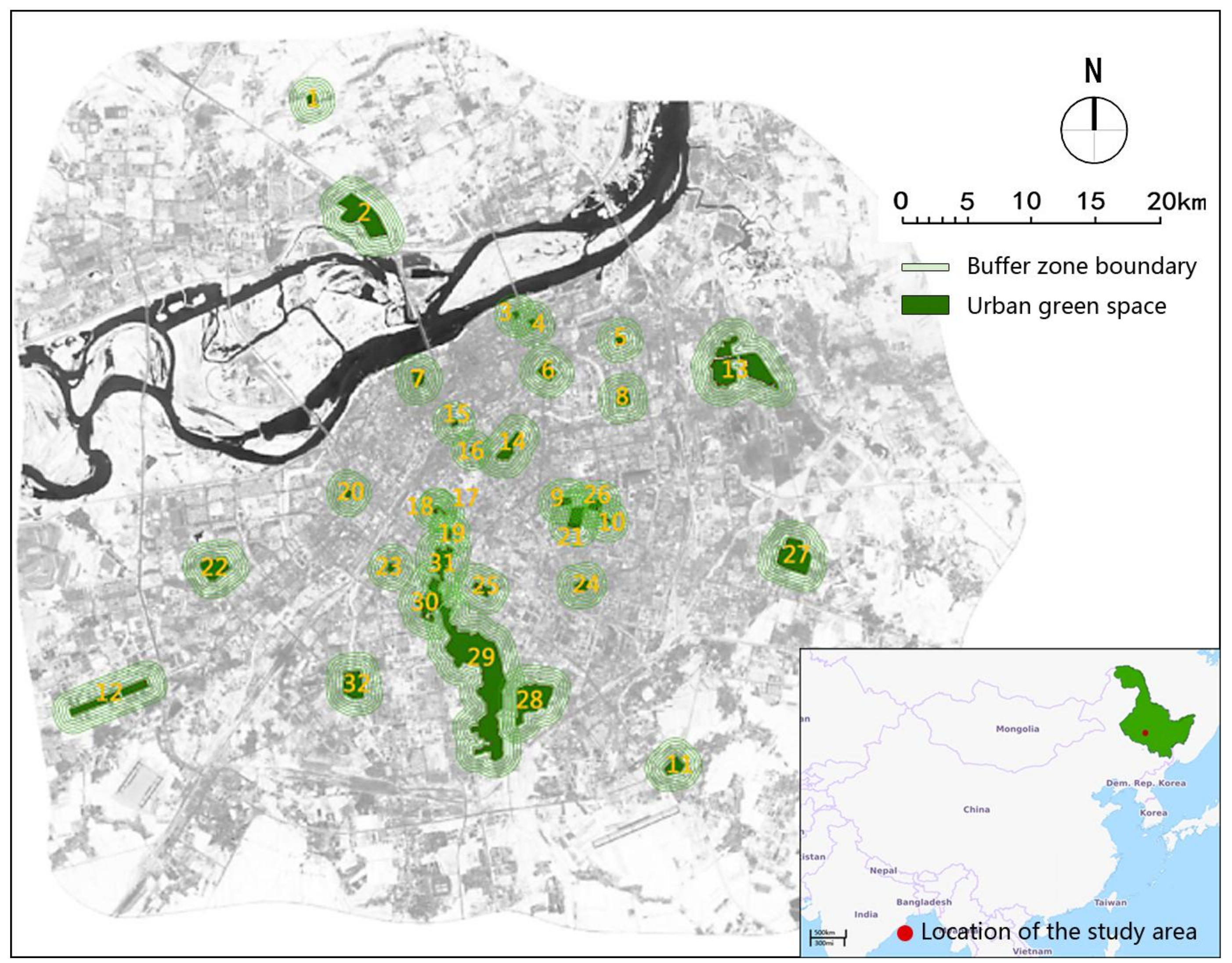





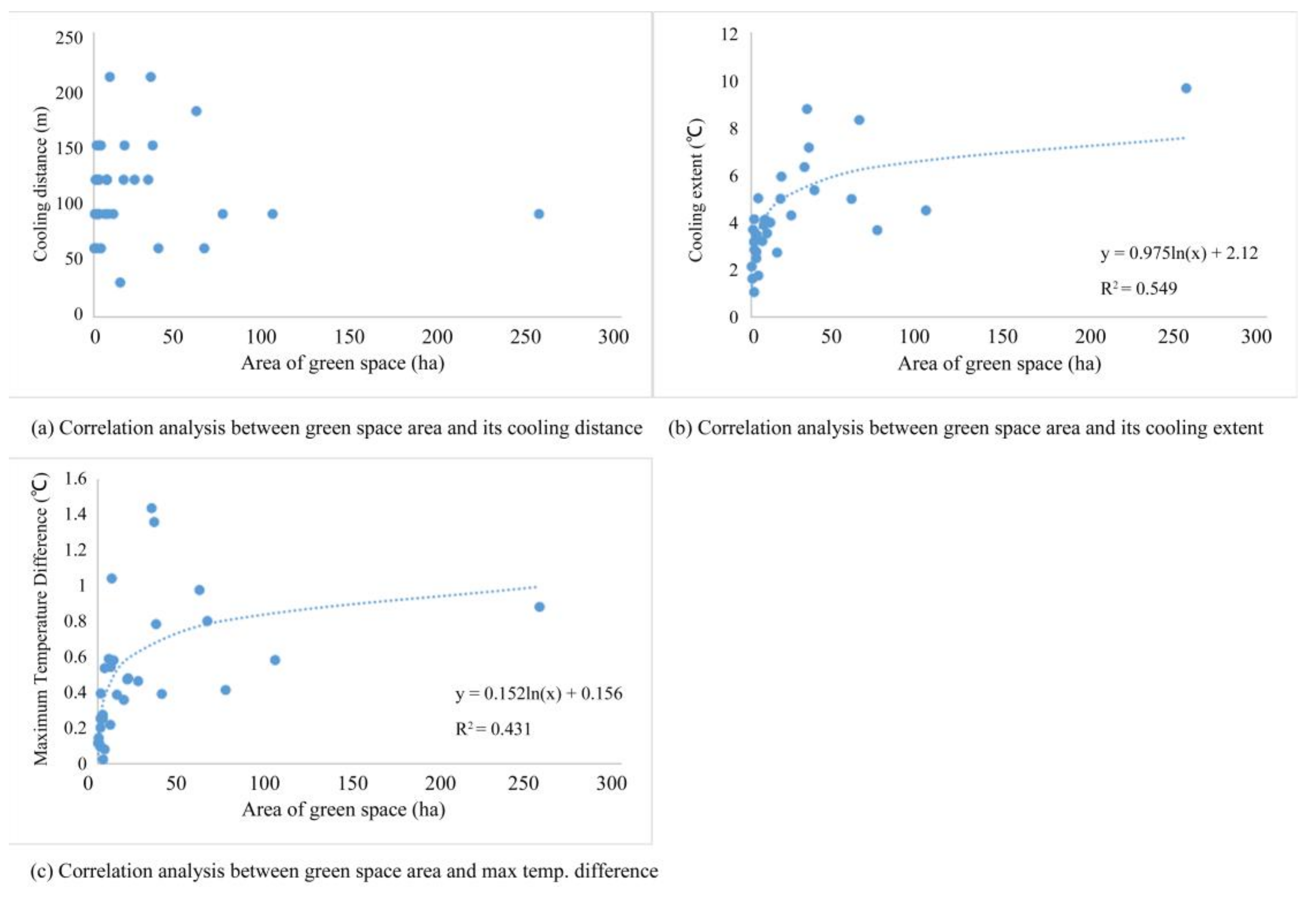
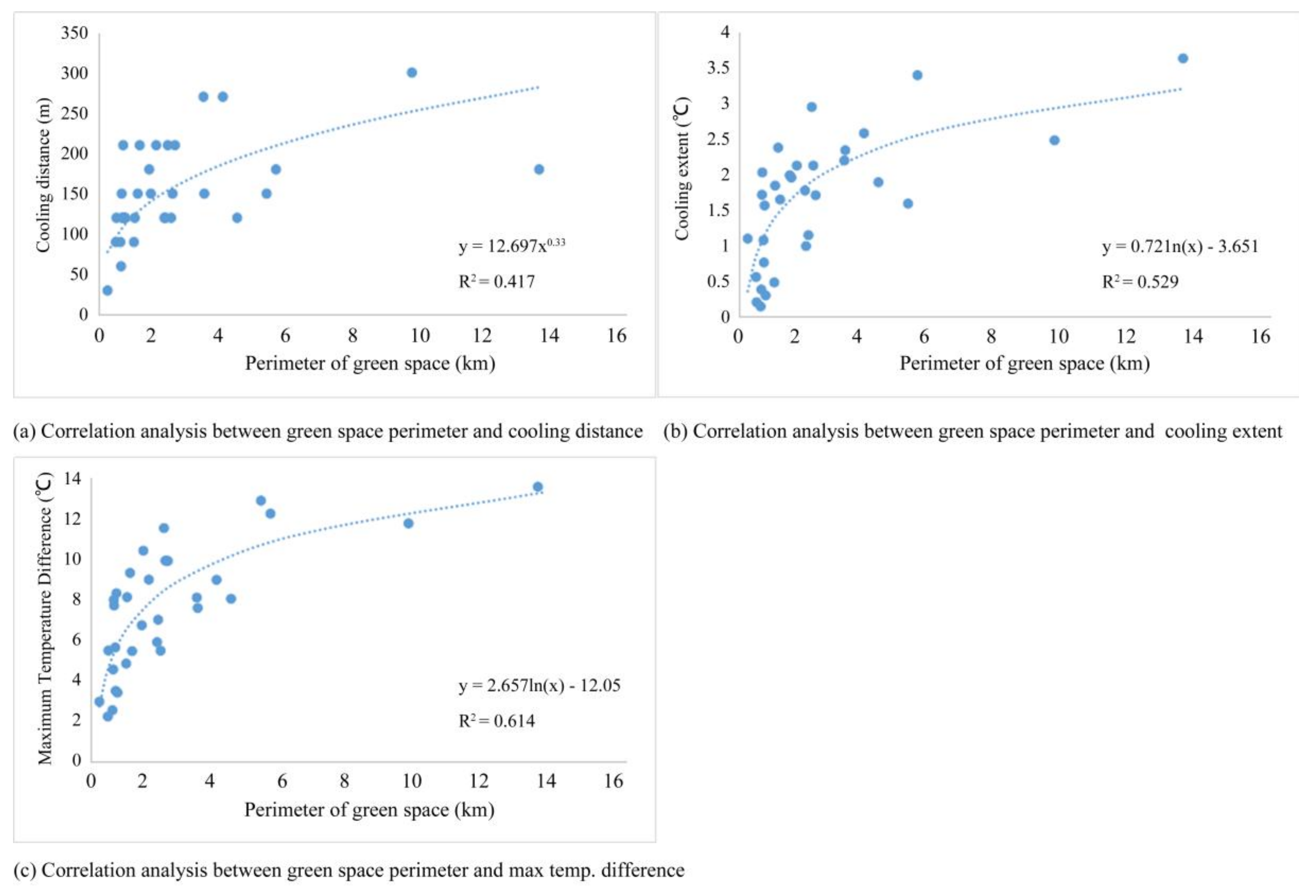
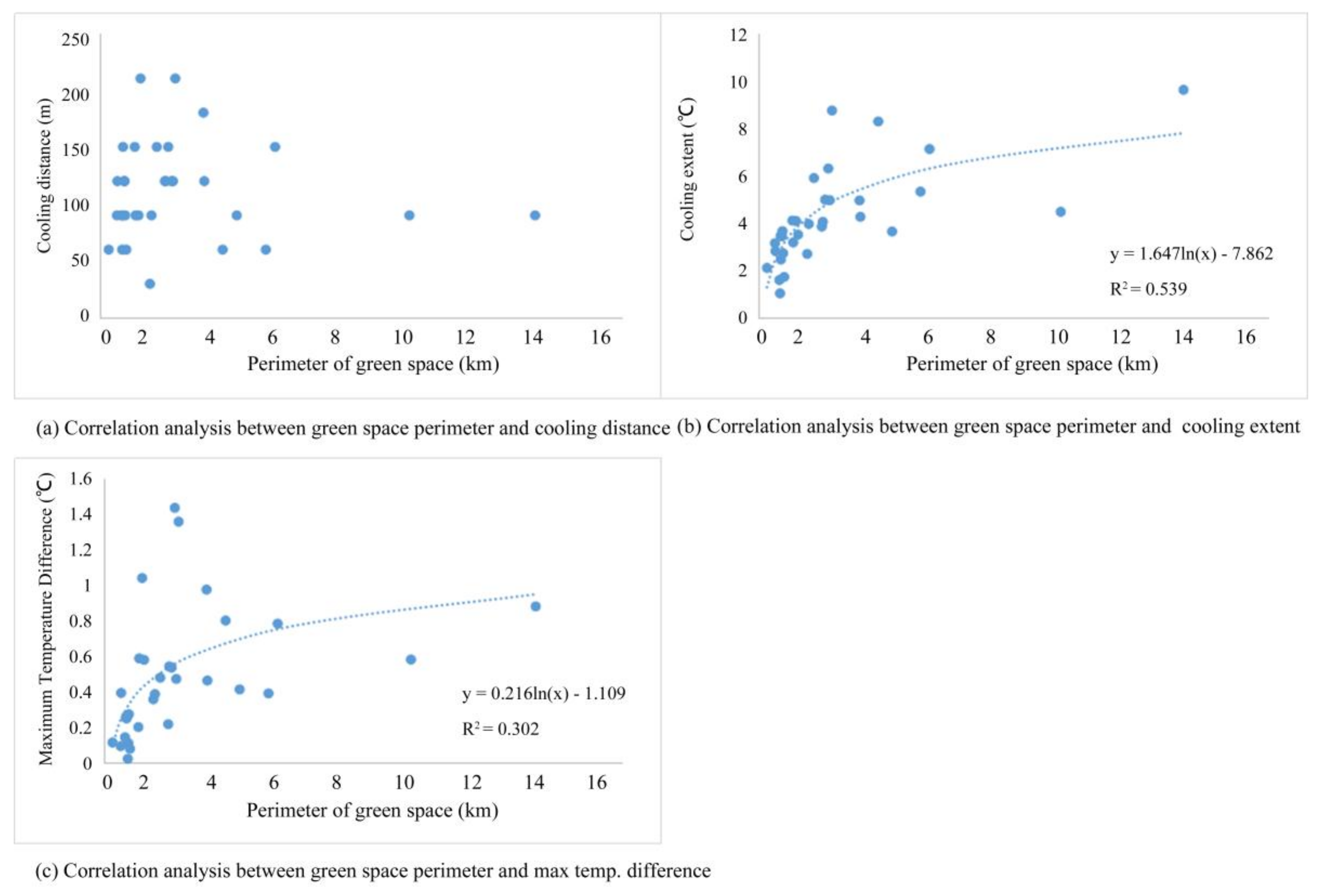
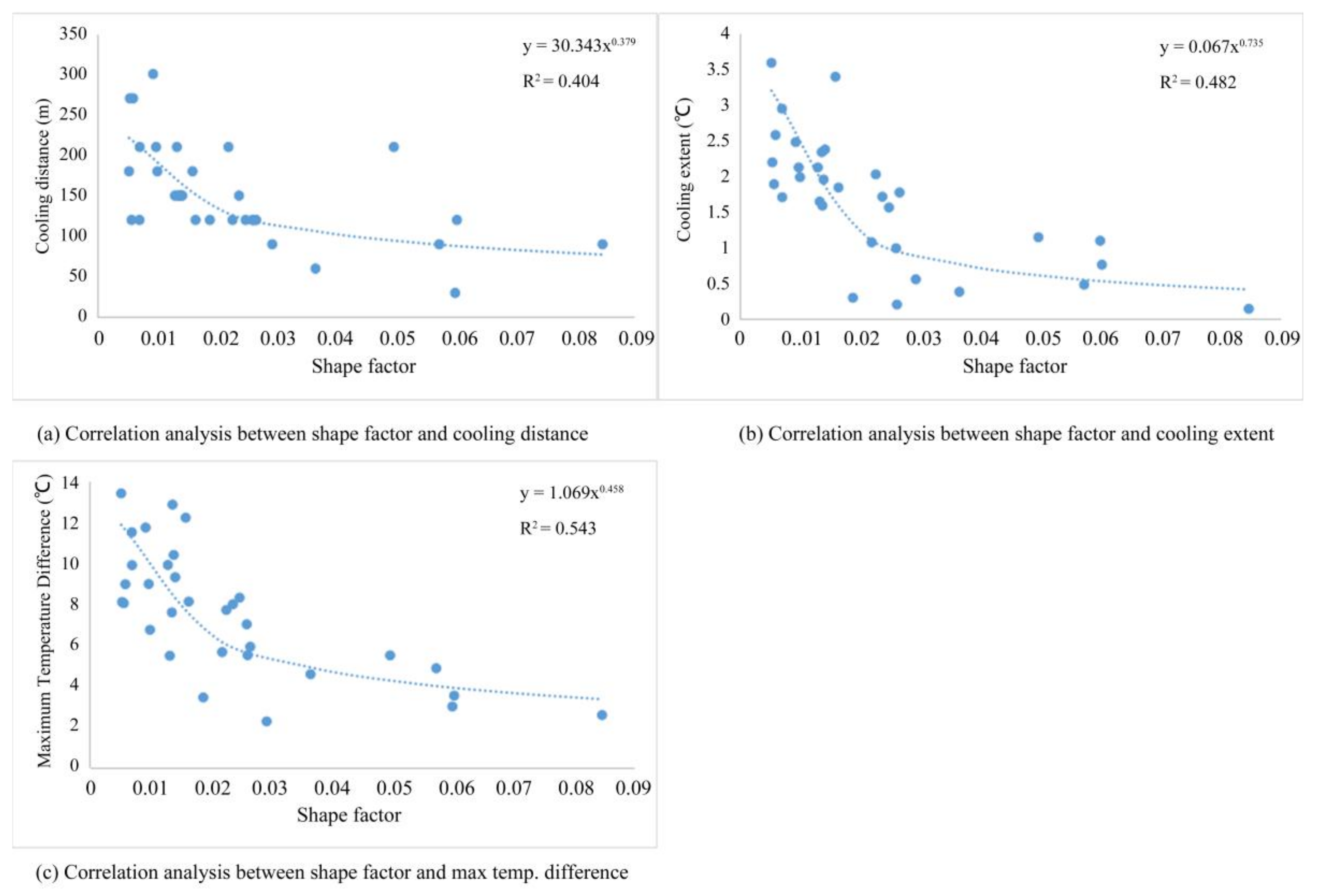
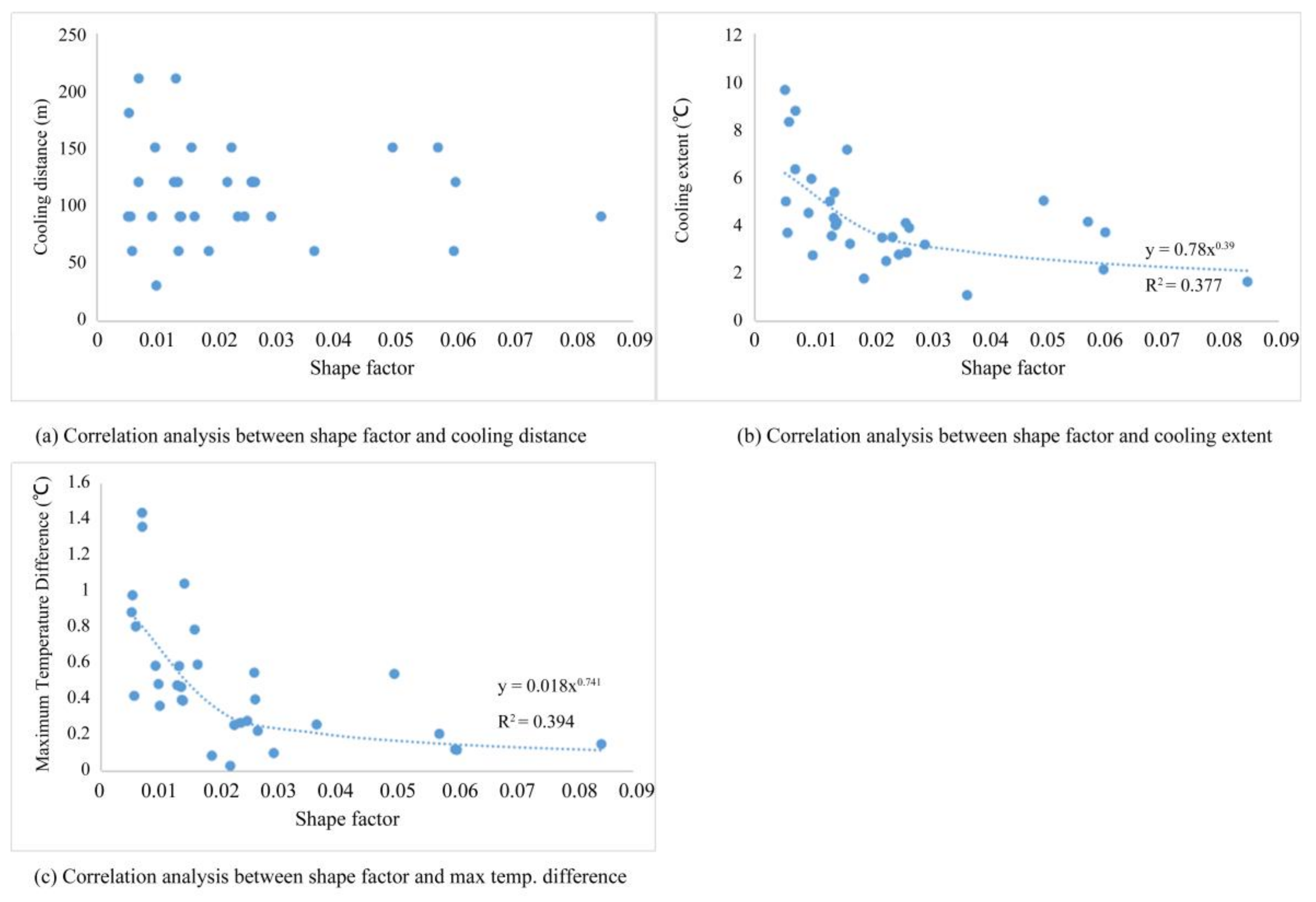
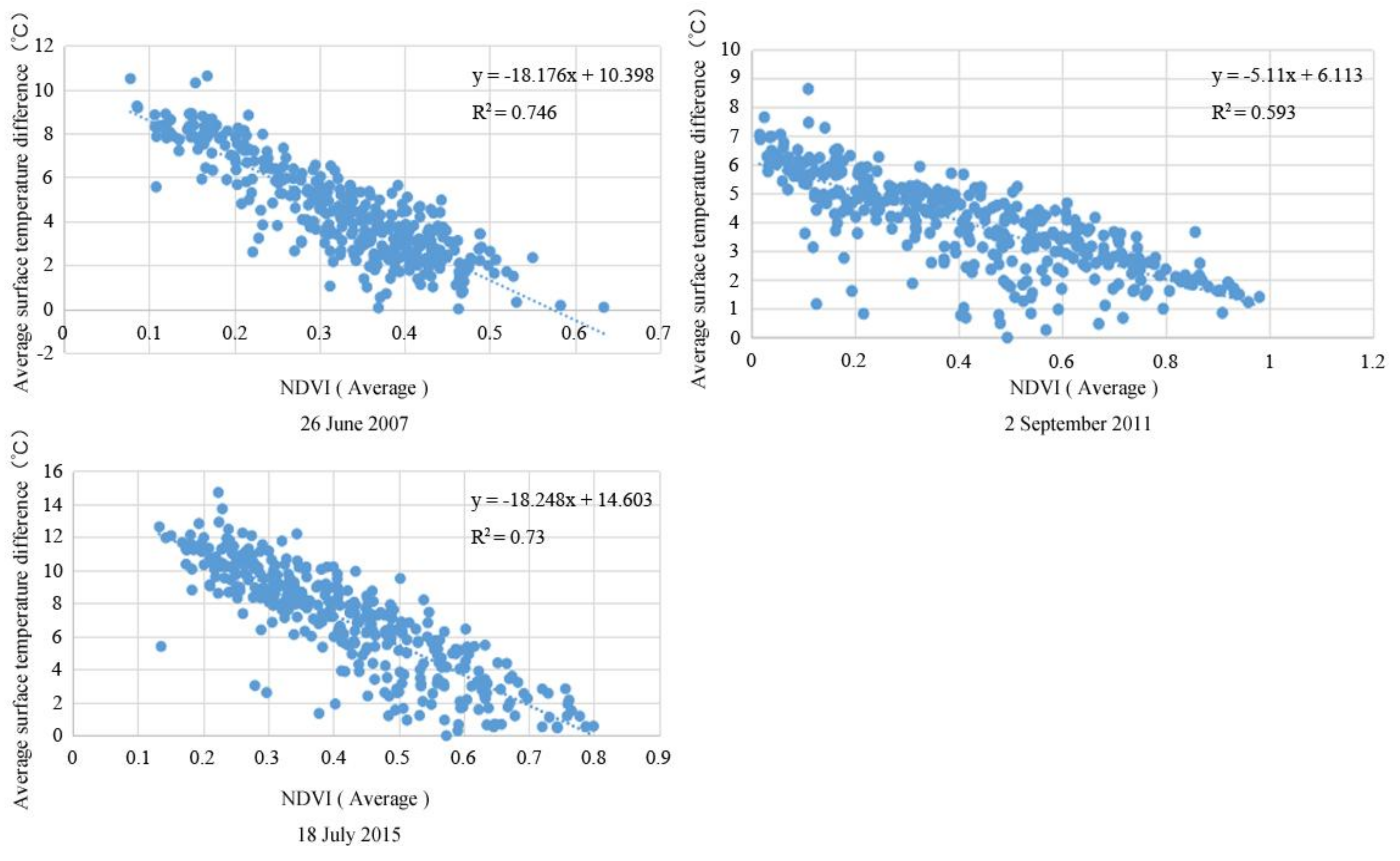
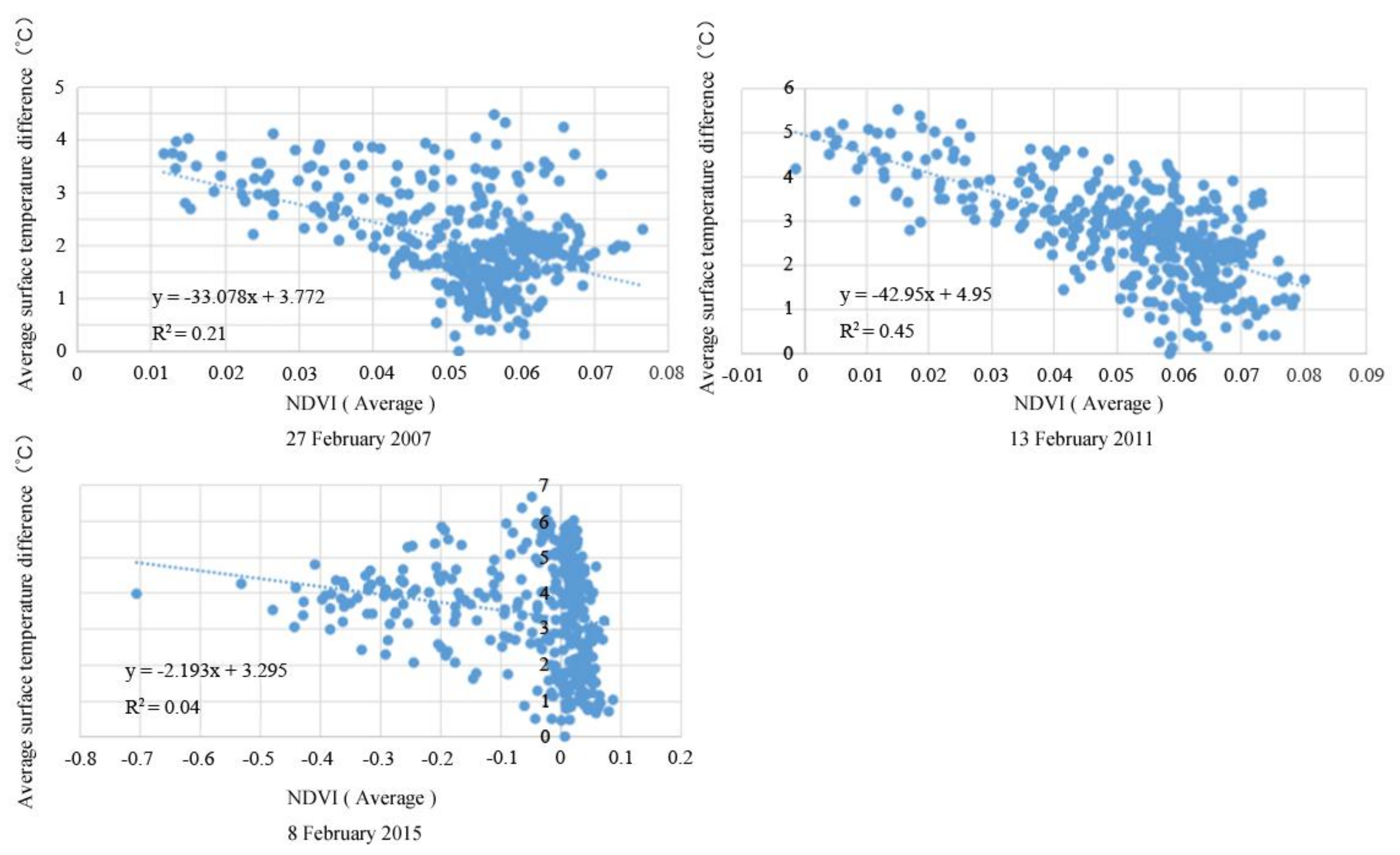
| UHI Grade | Relative Temperature | Meaning |
|---|---|---|
| 1 | <−0.2 | Strong cold island (SCI) |
| 2 | −0.2–0 | Weak cold island (WCI) |
| 3 | 0–0.1 | Weak heat island (WHI) |
| 4 | 0.1–0.2 | Medium strong heat island (MSHI) |
| 5 | 0.2–0.4 | Strong heat island (SHI) |
| 6 | 0.4–0.6 | Extremely strong heat island (ESHI) |
| No | Urban Green Space | Area (ha) | Shape Factor | P (m) | Summer | Winter | ||||||
|---|---|---|---|---|---|---|---|---|---|---|---|---|
| CD (m) | CE (°C) | MTD (°C) | CT | CD (m) | CE (°C) | MTD (°C) | CT | |||||
| 16 | Memorial hall green space | 0.43 | 0.060 | 259 | 30 | 1.10 | 2.96 | PV | 60 | 2.11 | 0.12 | PV |
| 17 | Siling street green space | 0.77 | 0.085 | 648 | 90 | 0.14 | 2.54 | PV | 90 | 1.60 | 0.14 | PV |
| 18 | HIT green space | 1.24 | 0.060 | 747 | 120 | 0.76 | 3.49 | PV | 120 | 3.66 | 0.11 | PV |
| 3 | Guandao Park | 1.75 | 0.029 | 511 | 90 | 0.56 | 2.23 | PV | 90 | 3.15 | 0.09 | PV |
| 19 | Majia river green space | 1.83 | 0.037 | 670 | 60 | 0.38 | 4.54 | PV | 60 | 1.04 | 0.25 | PV |
| 11 | Heilongjiang law school Landscape | 1.85 | 0.057 | 1059 | 90 | 0.48 | 4.83 | PV | 150 | 4.10 | 0.20 | PV |
| 15 | Jihong bridge green space | 2.02 | 0.026 | 527 | 120 | 0.20 | 5.47 | PV | 120 | 2.82 | 0.39 | PV |
| 4 | Jingyu Park | 2.90 | 0.024 | 688 | 150 | 1.71 | 7.96 | LV | 90 | 3.46 | 0.26 | PV |
| 20 | Jianguo Park | 3.09 | 0.023 | 699 | 120 | 2.02 | 7.68 | PV | 150 | 2.46 | 0.25 | PV |
| 23 | Qinbin Park | 3.09 | 0.025 | 767 | 120 | 1.56 | 8.28 | PV | 90 | 2.73 | 0.27 | PV |
| 5 | Taiping Park | 3.34 | 0.022 | 733 | 210 | 1.07 | 5.62 | UV | 120 | 3.44 | 0.02 | PV |
| 9 | Development area Park | 4.20 | 0.050 | 2087 | 210 | 1.14 | 5.46 | UV | 150 | 4.98 | 0.53 | LV |
| 1 | Lvshanchuan Park | 4.25 | 0.019 | 800 | 120 | 0.30 | 3.40 | UV | 60 | 1.73 | 0.08 | UV |
| 24 | Shangzhi Park | 6.61 | 0.016 | 1085 | 120 | 1.84 | 8.09 | LV | 90 | 3.18 | 0.59 | LV |
| 25 | Heilongjiang medicine university | 7.45 | 0.027 | 1983 | 120 | 1.77 | 5.88 | PV | 120 | 3.85 | 0.22 | LV |
| 26 | Water supply company green space | 7.74 | 0.026 | 2014 | 120 | 0.99 | 6.98 | PV | 120 | 4.05 | 0.54 | PV |
| 7 | Zhaolin Park | 8.28 | 0.014 | 1175 | 150 | 2.37 | 9.28 | LV | 90 | 4.08 | 1.04 | LV |
| 8 | Old Pear Garden | 9.29 | 0.013 | 1236 | 210 | 1.64 | 5.44 | LV | 210 | 3.51 | 0.58 | UV |
| 6 | Culture Park | 11.27 | 0.014 | 1572 | 150 | 1.95 | 10.37 | LV | 90 | 3.96 | 0.39 | PV |
| 10 | Dingxiang Park | 15.21 | 0.010 | 1524 | 180 | 1.98 | 6.71 | PV | 30 | 2.70 | 0.36 | PV |
| 14 | Children’s park green space | 17.19 | 0.013 | 2232 | 150 | 2.12 | 9.88 | LV | 120 | 4.96 | 0.47 | LV |
| 21 | Golf Course | 17.70 | 0.010 | 1736 | 210 | 2.12 | 8.95 | UV | 150 | 5.89 | 0.48 | PV |
| 32 | Eurasian Park | 32.62 | 0.007 | 2304 | 210 | 1.70 | 9.87 | PV | 210 | 8.73 | 1.35 | UV |
| 31 | Science Park | 23.42 | 0.014 | 3195 | 150 | 2.33 | 7.56 | LV | 120 | 4.26 | 0.46 | PV |
| 22 | Qunli Park | 31.14 | 0.007 | 2187 | 120 | 2.94 | 11.48 | LV | 120 | 6.29 | 1.43 | PV |
| 30 | NEFU green space | 33.70 | 0.016 | 5368 | 180 | 3.39 | 12.19 | LV | 150 | 7.11 | 0.78 | PV |
| 12 | Airport Expressway Landscape | 36.96 | 0.014 | 5084 | 150 | 1.59 | 12.83 | PV | 60 | 5.32 | 0.39 | UV |
| 27 | Tangdu Garden | 58.57 | 0.005 | 3168 | 270 | 2.19 | 8.07 | PV | 180 | 4.95 | 0.97 | PV |
| 28 | Songle Park | 63.08 | 0.006 | 3758 | 270 | 2.57 | 8.94 | PV | 60 | 8.27 | 0.80 | PV |
| 2 | Tiger Garden | 73.58 | 0.006 | 4192 | 120 | 1.89 | 8.01 | PV | 90 | 3.64 | 0.41 | PV |
| 13 | Fengjiawazi Garden | 101.97 | 0.009 | 9492 | 300 | 2.48 | 11.71 | LV | 90 | 4.47 | 0.58 | PV |
| 29 | Forest botanical Garden | 253.60 | 0.005 | 13,351 | 180 | 3.58 | 13.38 | LV | 90 | 9.60 | 0.88 | PV |
| Cooling Curve Type | CE (°C) | Standard Deviation | MTD (°C) | Standard Deviation | ||||
|---|---|---|---|---|---|---|---|---|
| Summer | Winter | Summer | Winter | Summer | Winter | Summer | Winter | |
| UV | 1.16 | 0.60 | 0.75 | 0.54 | 5.86 | 4.82 | 2.30 | 2.99 |
| LV | 2.40 | 0.57 | 0.66 | 0.30 | 9.76 | 4.21 | 2.36 | 0.77 |
| PV | 1.29 | 0.44 | 0.76 | 0.34 | 6.43 | 4.16 | 2.86 | 2.08 |
| CD (m) | 30 | 60 | 90 | 120 | 150 | 180 | 210 | 240 | 270 | 300 | |
|---|---|---|---|---|---|---|---|---|---|---|---|
| Summer | UV | 1 | 3 | ||||||||
| LV | 2 | 5 | 2 | 1 | 1 | ||||||
| PV | 1 | 1 | 3 | 7 | 1 | 1 | 3 | ||||
| Winter | UV | 1 | 1 | 1 | 1 | ||||||
| LV | 1 | 1 | 2 | 1 | |||||||
| PV | 1 | 3 | 8 | 5 | 4 | 1 | 1 |
| Correlation | Pearson | Kendall | Spearman | |||
|---|---|---|---|---|---|---|
| Summer | Winter | Summer | Winter | Summer | Winter | |
| 2007 | −0.864 | −0.458 | −0.643 | −0.206 | −0.830 | −0.309 |
| 2011 | −0.770 | −0.668 | −0.611 | −0.446 | −0.797 | −0.623 |
| 2015 | −0.855 | −0.200 | −0.685 | −0.185 | −0.869 | −0.281 |
© 2018 by the authors. Licensee MDPI, Basel, Switzerland. This article is an open access article distributed under the terms and conditions of the Creative Commons Attribution (CC BY) license (http://creativecommons.org/licenses/by/4.0/).
Share and Cite
Huang, M.; Cui, P.; He, X. Study of the Cooling Effects of Urban Green Space in Harbin in Terms of Reducing the Heat Island Effect. Sustainability 2018, 10, 1101. https://doi.org/10.3390/su10041101
Huang M, Cui P, He X. Study of the Cooling Effects of Urban Green Space in Harbin in Terms of Reducing the Heat Island Effect. Sustainability. 2018; 10(4):1101. https://doi.org/10.3390/su10041101
Chicago/Turabian StyleHuang, Meng, Peng Cui, and Xin He. 2018. "Study of the Cooling Effects of Urban Green Space in Harbin in Terms of Reducing the Heat Island Effect" Sustainability 10, no. 4: 1101. https://doi.org/10.3390/su10041101




